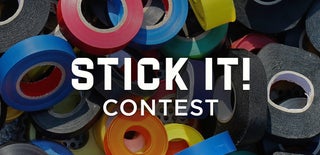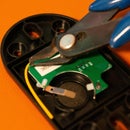Introduction: Magnetic Phone Holder With Wireless Charging
My dad and I have a lot in common: DNA, family, phones, a 2012 Prius. A while back my dad made a quick phone holder with wireless charging. All he did was hack a cheap phone holder to include a wireless charger. It was a nice start, but I always thought I could do better.
Here is why you should vote for me in the Stick It contest.
- This project uses magnets to....Stick the phone to the mount
- This project uses Epoxy to.... Stick the wood to the plastic
- This project uses double sided tape to... Stick the plastic to the car
3 different adhesives used together seamlessly to create an aesthetically pleasing phone mount. What could be better than that.
Problems with regular phone holders:
- Either magnetic or wireless charging, not both
- Ugly
- The clips holding phones on non magnetic chargers can interfere with the buttons
How my holder fixes these problems
- Includes magnetic docking AND wireless charging
- looks great
- Magnets hold phone, so no interference with buttons
Step 1: Tools/Materials
Tools:
- 3d printer
- hand saw
- 120, 180, 220, 400 grit sandpaper
- Random orbit sander
- air powered grinder or dremel
- Tin Snips
- 12" disk sander
- Tablesaw
Materials:
- wood (I used walnut)
- Watco Danish Oil
- 5/16" steel rod (or wood dowel)
- 6 (3/8" x 1/8" magnets)
- 3d filament
- thin metal plate
- foam mounting tape (not exactly what I used, but it should still work)
- wireless charger
Step 2: 3d Print
I modeled the phone holder in fusion 360 so you don't have to redesign it; here it is. If you don't have a 2012 Prius, you will have to make some simple modifications. The mount is specifically designed for the Prius, but there are several alternatives. One common car mount is an air vent clip. Another is a CD slot mount.
I printed mine with ABS, but I believe PLA would have worked just as well. Really, just use whatever you are comfortable with.
Step 3: Modify the Wireless Charger
The actual wireless charging is composed of two parts: a donut magnet, and a coil of wire. My magnet had a crack in it (I tested it and it still worked), so I put a thin layer of foam tape on it to hold it together. The advantage of foam tape is that it also holds the pcb from moving. Which may be important in a car (which is prone to a lot of vibrations.)
It's important for the wireless charger to be as close to the phone as possible, but there is a wire in the way. There are two wires for the coil. One is on the outside of the coil, but the other is on the inside. The inside wire is a problem because when it crosses over the coil it pushes the coil a little bit farther from the phone. If it were hard to fix, I don't think I would have; but it is really quite easy. Simply unsolder the inner wire, put it through the hole in the magnet, and solder it back on.
The final modification is maybe the easiest yet. Bend the led charge indicator down and put hot glue between the led legs and the pcb. While you are at it, hot glue the end of the usb port. Hot glue between the pcb and the led legs will prevent a short circuit. Hot glue on the end of the port will make sure it doesn't break off if there is pressure on the charging cable.
Step 4: Clean Up the 3d Prints
After printing the parts, I removed the supports with pliers and an air powered cutting thing (basically an air powered Dremel). Then I used my orbital sander with 220 grit sandpaper to smooth the ridges in the 3d print. I really like the finish I can achieve with this technique.
Step 5: Prepare Dowel
Take your dowel (wood or metal) and cut it to length. Cut it flush, or a little larger if you like the way it looks. If it's metal, file both ends so they are really flat. Then sand the whole thing so it looks clean. If it is wood, just sand it and then finish it.
Step 6: Prepare the Wood
I had big plans for the wood portion. I was going to cnc a really thin plate with four pins that would insert into the plastic portion to yield a beautiful product. Although I did end up with a beautiful product, I didn't end up using a cnc router to do it. The reason I didn't is that the computer that runs our cnc is really old. When we went to turn it on it auto updated to windows 10. Windows 10 made the computer really slow. I don't know how to use the cnc router yet, so my dad was doing all of this, and by the time he got the cnc up and running I had finished the project.
- Cut a piece of wood really thin
- Sand it until it's super duper smooth on one side (the other side should be flat, but no need to go past 180 or 220)
- Cut it until it is only slightly bigger than the plastic part
Step 7: Assemble (faceplate)
Hang tight! You're almost done!
- Plug in the wireless charger and put it in its place (with it plugged in)
- Put some hot glue on the wireless charging pad to hold it in place for these next steps
- Place all the magnets into the plastic
- Mix up some epoxy
- Pour epoxy onto the plastic part, and pour any extra into/onto the wireless charger to hold it in place
- Clamp the wood to the plastic, the more clamps the better
Step 8: Trim and Finish
Use a fine tooth saw to trim the wood and epoxy until it's as flush as possible. Then take the orbital sander with 220 grit sandpaper and sand the wood until the wood and plastic are completely flush. I then used my Dremel torch to heat the ABS; which gives the ABS a richer color (only works if pre-sanded). Using a finish of your choice (I always use Watco Danish Oil because it's what I have in my shop) finish the wood facade. With Danish Oil, you put a thick layer on, let it soak in for a up to 20 minutes, then wipe off as much oil as you can.
Step 9: Attach the Metal Plane to the Phone
The metal plate I bought was too large for my phone because my phone is curved but the metal isn't. I tried cutting it with several different tools. Only one seemed to work well, tin snips. I tried a hacksaw, a jigsaw, and a bandsaw (with a wood blade, metal might work great). The metal is so thin that all of these tools bend the metal. After cutting it, use a sander to flatten the cut and then round the corners.
Before you stick the metal to your phone for good, test it with the wireless charger to make sure the metal isn't in the way. If you put it really close to the bottom it should work great.
Step 10: Assemble (3d Prints) & Mount
See the video for assembly, but it's pretty straightforward. Insert one plastic part into the other, and then put the pin in place.
Place the phone holder in its final resting position to make sure you know where it needs to go when you go to stick it on. Put the mounting tape on, take off the plastic, and stick the whole thing to your car. You're done!
Step 11: The End
Thanks for reading. I hope you learned something. If you make one of your own, please let me know; I love seeing other peoples creations.
I had a great time working on this project, and get to enjoy it every time I drive. Not only does it look good without a phone, it is so satisfying to place my phone on it.

Runner Up in the
Stick It! Contest













